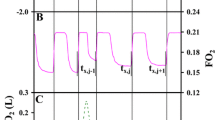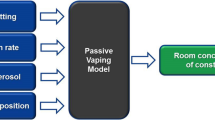Abstract
A previously developed mathematical model that describes the relationship between blood alcohol (ethanol) concentration and the concentration of alcohol in the exhaled breath at end-exhalation (BrAC) has been used to quantitate the effect of pretest breathing conditios on BrAC. The model was first used to “condition” the airways with different breathing maneuvers prior to simulating a single exhalation maneuver, the maneuver used in standard breath alcohol testing. On inspiration, the alcohol in the air reaches local equilibrium with the alcohol in the bronchial capillary bed prior to entering the alveolar region. On expiration, approximately 50% of the alcohol absorbed on inspiration is desorbed back to the airways. BrAC correlates with the amount of alcohol that is desorbed to the airways. The six pretest breathing conditions and the percent change in BrAC relative to the control maneuver were: hyperventilation (−4.4%), hypoventilation (3.7%), hot-humid air (−2.9%), hot-dry air (0.66%), cold-humid air (0.13%), and cold-dry air (0.53%). The mechanism underlying these responses is not due to changes in breath temperature, but, rather to changes in the axial profile of alcohol content in the mucous lining of the airways.
Similar content being viewed by others
References
Aharonson, E. F., H. Menkes, G. Gurtner, D. L. Swift and D. F. Proctor. Effect of respiratory airflow rate on the removal of soluble vapors by the nose.J. Appl. Physiol. 37:654–657, 1974.
Bird, R. B., W. E. Stewart, and E. N. Lightfoot. Transport Phenomena, New York: John Wiley & Sons, 1960, p. 354.
Chilton, T. H., and A. P. Colburn. Mass transfer (absorption) coefficients: Prediction from data on heat transfer and fluid friction.Ind. Eng. Chem. 26:1183–1187, 1934.
Dahl, A. R., M. B. Snipes, and P. Gerde. Sites for uptake of inhaled vapors in beagle dogs.Toxicol. Appl. Pharm. 109:263–275, 1991.
Dubowski, K. M. Breath-alcohol simulators: Scientific basis and actual performance.J. Anal. Toxicol. 3:177–182, 1979.
George, S. C., A. L. Babb, and M. P. Hlastala. Dynamics of soluble gas exchange in the airways: III. Single exhalation breathing maneuver.J. Appl. Physiol. 75:2439–2449, 1993.
Hanna, L. M., and P. W. Scherer. Measurement of local mass transport coefficients in a cast model of the human upper respiratory tract.J. Biomech. Eng. 108:12–18, 1986.
Hildebrandt, J. Structural and mechanical aspects of respiration. In: Textbook of Physiology, edited by H. D. Patton, A. F. Fuchs, B. Hille, A. M. Scher and R. Steiner. Philadelphia: W.B. Saunders Co., 1989, Vol. 2, p. 995.
Hindmarsh, A. LSODE (computer program). Lawrence Livermore Laboratory, 1981.
Ingenito, E. P., J. Solway, E. R. McFadden, and J. M. Drazen. A quantitative study of heat transfer coefficients in the upper tracheobronchial tree of man (Abstract).Fed. Proc. 45:1020, 1986.
Iravani, J., and A. v., As. Mucus transport in the tracheobronchial tree of normal and bronchitic rats.Pathologe 106:81–93, 1972.
Jones, A. W. Effects of temperature and humidity of inhaled air on the concentration of ethanol in a man's exhaled breath.Clin. Sci. 63:441–445, 1982.
Jones, A. W. How breathing technique can influence the results of breath-alcohol analysis.Med. Sci. Law. 22:275–280, 1982.
Jones, A. W. Quantitative measurements of the alcohol concentration and the temperature of breath during a prolonged exhalation.ACTA Physiol. Scand. 114:407–412, 1982.
Jones, A. W. Determination of liquid/air partition coefficients for dilute solutions of ethanol in water, whole blood, and plasma.J. Anal. Toxicol. 7:193–197, 1983.
Luchtel, D. L. The mucous layer of the trachea and major bronchi in the rat.Scan. Elect. Micro. 2:1089–1098, 1978.
McFadden, E. R., B. M. Pichurko, H. F. Bowman, E. Ingenito, S. Burns, N. Dowling, and J. Solway. Thermal mapping of the airways in humans.J. Appl. Physiol. 58:564–570, 1985.
Morris, J. B., and D. G. Cavanagh. Deposition of ethanol and acetone vapors in the upper respiratory tract of the rat.Fund. Appl. Toxicol. 6:78–88, 1986.
Newman, W. H., and P. P. Lele. A transient heating technique for the measurement of thermal properties of perfused biological tissue.J. Biomech. Eng. 107:219–227, 1985.
Ohlsson, J., D. D. Ralph, M. A. Mandelkorn, A. L. Babb, and M. P. Hlastala. Accurate measurement of blood alcohol concentration with isothermal rebreathing.J. Stud. Alcohol. 51:6–13, 1990.
Schrikker, A. C. M., W. R. de Vries, A. Zwart, and S. C. M. Luijendijk. Uptake of highly soluble gases in the epithelium of the conducting airways.Pflugers Arch. 405:389–394, 1985.
Solway, J., B. H. Pichurko, E. P. Ingenito, E. R. McFadden, Jr., C. H. Fanta, R. H. Ingram, Jr., and J. M. Drazen. Breathing pattern affects airway wall temperature during cold air hyperpnea in humans.Am. Rev. Resp. Dis. 132:853–857, 1985.
Tsu, M. E., A. L. Babb, E. M. Sugiyama, and M. P. Hlastala. Dynamics of soluble gas exchange in the airways: II. Effects of breathing conditions.Resp. Physiol. 83:261–276, 1991.
Tsu, M. E., A. L. Babb, D. D. Ralph, and M. P. Hlastala. Dynamics of heat, water, and soluble gas exchange in the human airways: I. A model study.Ann. Biomed. Eng. 16:547–571, 1988.
Weibel, E. Morphometry of the Human Lung. New York: Springler-Verlag, 1963.
Author information
Authors and Affiliations
Rights and permissions
About this article
Cite this article
George, S.C., Babb, A.L. & Hlastala, M.P. Modeling the concentration of ethanol in the exhaled breath following pretest breathing maneuvers. Ann Biomed Eng 23, 48–60 (1995). https://doi.org/10.1007/BF02368300
Received:
Revised:
Accepted:
Issue Date:
DOI: https://doi.org/10.1007/BF02368300




